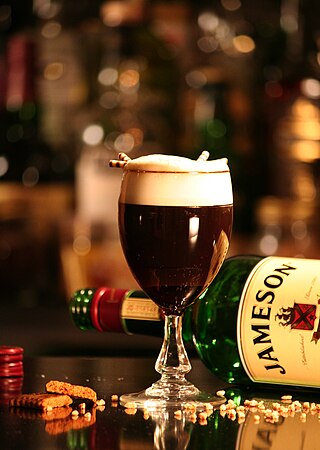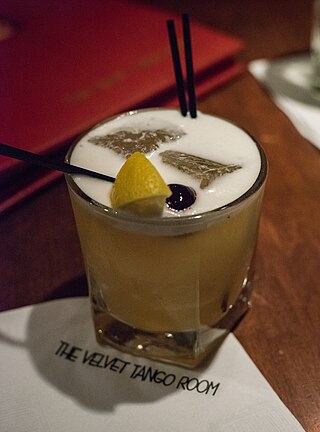
The martini is a cocktail made with gin and vermouth, and garnished with an olive or a lemon twist. Over the years, the martini has become one of the best-known mixed alcoholic beverages. A popular variation, the vodka martini, uses vodka instead of gin for the cocktail's base spirit.

Disaronno Originale is a type of amaretto—an amber-colored liqueur with a characteristic almond taste, although it does not actually contain almonds. It is produced in Saronno, in the Lombardy region of Italy, and is sold worldwide. According to the company, the liqueur is an infusion of apricot kernel oil with "absolute alcohol, burnt sugar, and the pure essence of seventeen selected herbs and fruits". The liqueur is sold in an oblong glass decanter designed by a craftsman from Murano.

Crème de Noyaux is an almond-flavored crème liqueur, although it is actually made from apricot kernels or the kernels of peach or cherry pits, which provide an almond-like flavor. Both Bols and Hiram Walker produce artificially colored red versions of the liqueur while Noyau de Poissy from France is available in both clear (blanc) and barrel-aged amber (ambre) versions.

Ratafia is a broad term used for two types of sweet alcoholic beverages, a flavouring essence whose taste resembles bitter almonds, later to a ratafia flavoured biscuit, a biscuit to be eaten along with ratafia, and later still, to a cherry variety.

A sour is a traditional family of mixed drinks. Sours belong to one of the old families of original cocktails and are described by Jerry Thomas in his 1862 book How to Mix Drinks.
Amaretto is an almond-flavored Italian liqueur.

An apricot kernel is the apricot seed located within the fruit endocarp, which forms a hard shell around the seed called the pyrena.

A liqueur coffee is a caffeinated alcoholic drink that consists of a shot of liqueur, mixed with coffee. It is typically served in a liqueur glass, often accompanied with cream and sugar. Coffee liqueur beverages are served in different fashions and can be found throughout many countries. One of the most popular liqueur coffee beverage is commonly known as Irish coffee. Liqueur coffee beverages are largely classified as cocktails as well as digestifs which are aimed at aiding the digestive process typically after a meal.

The Fine Art of Mixing Drinks is a book about cocktails by David A. Embury, first published in 1948. The book is noteworthy for its witty, highly opinionated and conversational tone, as well as its categorization of cocktails into two main types: aromatic and sour; its categorization of ingredients into three categories: the base, modifying agents, and special flavorings and coloring agents; and its 1:2:8 ratio for sour type cocktails.

An amaretto sour is a cocktail using amaretto liqueur. It is a type of sour, a mixed drink made with a base spirit, citrus juice, and a sweetener. The drink is the most popular cocktail use for amaretto.

The Godfather is a duo mixed drink made of Scotch whisky and amaretto. Typically, the drink is served with ice in an old fashioned glass.
The Ritz Fizz was created as the Ritz-Carlton hotel chain's signature cocktail in 1934 upon the repealing of prohibition in the United States. It was first concocted in the bar at The Ritz-Carlton Hotel in Boston, Massachusetts.
Maple liqueur refers to various alcoholic products made from maple syrup, primarily in the Northeast United States and Canada. It is most commonly made by mixing Canadian rye whiskey and Canadian maple syrup. Maple liqueur is considered an important cultural beverage in certain Canadian festivals.

Amaretti di Saronno are a type of amaretto, a bitter-sweet flavored macaroon, that is traditional to Saronno, a comune (municipality) of Lombardy, Italy. It is one of many types of traditional amaretti, but the only one made with apricot kernels.
An astro pop cocktail is a layered cocktail, mixed drink or shooter so named because it resembles the Astro Pop lollipop candy brand. Various recipes exist that use liquor and liqueurs to produce the drink. A version of the drink exists that is layered with red, white, and blue colors and served in a shot glass. It is a popular alcoholic beverage in some drinking establishments.

Bitter almond liqueur, is a Portuguese sweet alcoholic liquor, more specifically from the Algarve region. Clear light yellow in colour and with roughly 20% ABV, it is one of the most well-known liqueurs in its country of origin. It is made from the seeds of the bitter almond, and is similar in flavour to the Italian Amaretto.












